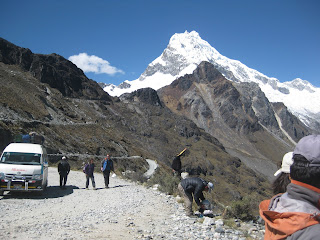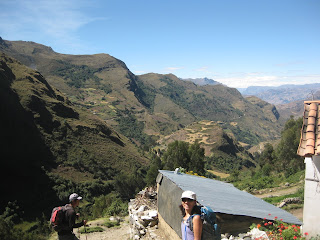July 8, 2015
The Santa Cruz Trek Day One
Before we began the hike we had to get some logistical
complications out of the way. In Peru, there are always complications. These may
involve traffic, or cars not showing up at the right time, or the correct
people not showing up with the cars, or papers being misplaced, or plumbing
that doesn’t work, or things that simply take a lot longer than they are
supposed to. As jump off time approached, we really had no idea what these
logistical complications would be…only that there would be some.
The morning of the hike we discovered the first complication
– the guides who were supposed to pick us up at the hotel showed up on time.
This is, by Peruvian standards, a major faux pas…it simply is not done. After
some bewildered apologies, the frantic dragging of suitcases and hasty
arrangement of packs, we were finally underway…to an adjacent hiker hostel a
few blocks away where our guides picked up two additional tourists and the
entire scene was repeated.
We then got underway for real. First we drove over blacktop
roads to the small city of Yungay. Along the way, every person on the route
attempted to hail us for a ride…the van we were travelling in apparently looked
sufficiently bus-like to be taken for one. At Yungay, there was a brief stop to
pick up supplies. The method used by Peruvian guides to procure supplies is
this: at a certain unnamed point the car will stop, all the guides will get
out. Nothing will be said, and no explanation will be given. Then a short time
later all will get back in the car, and the car will drive off without any
further explanation. If this happens to you, you will know you have been at a
re-supply stop.
Soon the car turned off the main
road, headed uphill, and then too a sharp left where the
streets abruptly turned to oblivion. Then it was hours, hours winding along a
tiny dirty road that led to no place in particular, just high in the Andes.
We had been told we would stop for coffee mid route (we did
at about the three hour mark) and then continued on to the entrance of
Huascarin National Park. At the Ranger station, we presented our tickets and
the guides did whatever else had to be done and said whatever else had to be
said to the officials. We were, like most tourists, not turned away.
But we weren't even close to being there yet, We drove on. Little did I know it but this was the famous
(or infamous) Portachuelo de Llanganuco, the mountain road that many consider to be as dramatic as the hike itself. You get close – very close – to the edge here. As this road winds impossibly up, making you wonder how two vehicles could possible pass at once, the views become….otherworldly.
Us with Nevado Huascaran, Peru's highest mountain.
We kept on, and soon we passed through a blind cut dynamited into the rock (the driver furiously honking the horn to warn anyone coming through the other way) and burst out on the other side of the mountains. And then we went down, down down…for another good hour. And I thought the guides were doing us a favor. Views of glaciers and massive Huascaran receded, replaced by dry scrub; soon we arrived at the very small roadside town of Vaqueria – we had at last reached our starting point.
We piled out and began sorting things out. First a stop to the banos which, for a few coins, a woman operating a local store gladly offered us. Little did we know that these would be the last real toilets for three days. While our guides rounded up the mules, we repacked our gear. We had been wondering if, as in Salkantay, the mules would be able to transport some of our gear…which was definitely helpful for the both of us but particularly Sylvia who, ahem, had not carried her full pack since then. That was three years ago. The guides were agreeable and soon, after re-packing, de-layering and applying sunscreen (it was quite hot) we did what only donkey’s and gringo’s do at noon.
As we trundled downward, me tottering on my knobby knees and
dreading as always these downhills, a large group of young trekkers ambled by.
Parts of this group had shared the bus in with us…college aged hikers from
Europe and Israel, fresh-legged, hiking without poles. They moved by fast and
purposefully, and I envied their youth and the fresh cartilage in their joints.
Later on, at the end of day two, we passed a lot of these same kids, then
reduced to walking zombies, gassed, wiped out by the altitude. I bet they were
wanting that sprinting start back.
Our hike eventually brought us across the river at the
valley’s bottom and up the other side of the slope to a small village which may
have been Colcabamba. There we met up with our first, er, complication of the
hike itself. After conferring with one of the other passing porters, Freddie
told us that the mules were ‘delayed’ for some reason, and therefore there was no
rush since we had to let them catch up to us anyway. (What he actually was
told, translated later by Sylvia, was that there some doubt about any mules
being left for hire in Vaqueria. But he promptly assured us this was not so,
there would be a camp set up for us.)
After a short rest we resumed hiking. The trail ran beside
farm houses, some of which were raising the local delicacy, cuy…which most of you
will recognize as guinea pigs. But if this creeps you out rest assured there
were plenty of conventional barnyard animals milling about everywhere too…cows, pigs,
sheep, goats, hens and noisy roosters, horses and of course, mules. After nervously passing several pigs at close
proximity (you have to give pigs the respect you would a large dog) we finally
came upon one in field which Sylvia pronounced to be “very clean.” “This pig is
much cleaner than many others that I have seen so far,” she said, with a very
stern look in my direction. We left this well-manicured porker behind and
continued our trek.
This was about where we passed the last vendor selling bottled water (or anything else.)
We walked until dusk overtook us and the temperature dropped,
at times accompanied by a small train of curious local children hoping for
cookies. At some point after parting ways with the clean pig, we passed the
last kiosk where anything including water was sold (we had no idea we were
passing it until it was long gone.) We then crossed over into the national
park, stopped briefly at the ranger station to check in, and then continued
past the first campsite to our day’s destination…which I think was either Paria
or possible Tuctubamba. The mules passed us, finally, as we were layering up,
and after crossing a small makeshift bridge over a rushing stream, we came upon
the cook, Edwin, and the mule driver setting up the tents.
All of the (in)conveniences of home, including cold and cold running water.
Here was where Sylvia’s ‘awakening des rude’ occurred. There
was, first off, no spot anywhere that was not covered in animal turds…not one.
Sometimes the turds were very old and the remains of them were like powdered dust,
while others were visibly fresh…but they were everywhere. We put our packs down
on a nearby rock, not because the rocks were poop free but because…well, we had
to put them somewhere.
The second, and more shall we say impactful, revelation came as we watched
the mule driver hurry off a hundred yards of so to set up our camps ‘powder
room.’ Now, I had read trip reports which said that bathrooms were available on
the trek, thought they were infrequent and crowded. This turned out to be untrue
on all levels…they weren’t crowded, they weren’t infrequent. They simply
weren’t. Our guides helpfully erected a privacy screen (sort of a nylon
outhouse) around the plumbing itself, which was…a latrine. If you do not know
what a latrine is, ask somebody who has been in the army. Or just go out back
and start digging a roundish hole in your backyard, about the width of the
business end of a commode, and when you’ve gone down about two feet…you’ve got
yourself a latrine.
Sylvia was NOT pleased. But, this ‘powder room’ did have
three things going for it….location. Location. And…location.
After the camp was thrown together the guides served us hot
cocoa leaf tea, which was welcome, and apparently helps with the altitude. It
was starting to get cold…very cold. You lose the light quick in the mountains,
and the sun sets quickly in the tropics to begin with. After tea we layered up
with everything we had…our own tent was set up by the guides…and then it was
inside the warm cook tent for a dinner of soup and roast chicken that REALLY
warmed us up. Boy did that hit the spot! Before retiring that night I spent a
few minutes outside the tent, headlamp off, just looking at the amazing display
of stars…the Milky Way, the Great Sky River as Native Americans called it,
shown brightly in the midst of tens of thousands of stars. You could see the
nearby snow-capped mountains clearly in the starlight…It would be a cold night
and we had a hole in the ground for bathroom but I could not think of a more
beautiful place to be.
But I returned to the tent determined to get a good rest
because tomorrow would bring us to Punta Union.












No comments:
Post a Comment